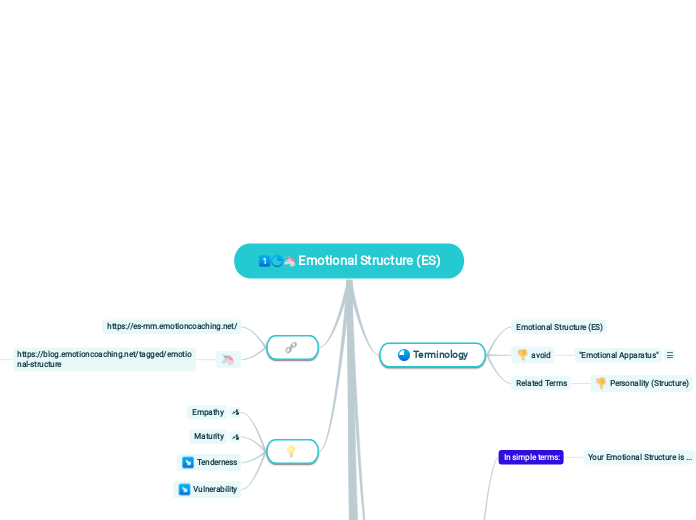por Medizin Wissen hace 3 años
450
Emotional Structure (ES)

por Medizin Wissen hace 3 años
450

Ver más
/understood it/figured it out..."
I have cried so much.
"I have talked about it - I don't want it anymore."
ex.
lawyer who is in abusive rel.
in that area
cognitive
rational
Sign of a mature Emotional Structure: You produce tenderness when perceiving vulnerability."--MB
You produce tenderness when perceiving vulnerability.
etc.
hormonal state
it can change - it is not constant
Processing of emotions is an example to deliberately catalyze a change in the emotional structure
Processing (of Emotions)
define
mostly attributed to influencing factors
One's emotional structure cannot be changed by "wanting" or "deciding" so.
Popular belief is different:
There are countless examples in popular culture to express the notion that "I want to feel less (or more)", for example. The fact that this is expressed to frequently might lead us to believe that it could work. In fact, it does not. The expressions describe the emotional situation of a person and the pain which this person experiences may or may not cause the change, but the "wishing"/"wanting" of the same had little to do with it.
the experience of pain is the main reason for changes of one's emotional structure
both an increase and decrease of empathy are happening exclusively through the experience of pain:
a constructive experience of pain, i.e. happening in a context of sufficient emotional resources, etc. the Emotional Structure will change towards the ability to experience more Empathy
it is central to Emotional Processing to purposefully create these
an unconstructive experience of pain, i.e. associated with helplessness, being overwhelmed etc. leads to a decrease of the ability to experience Empathy
decrease of Empathy
Numbing / increase in (emotional) numbness
increase of Empathy
/ sensitivity
Like for the sound of most instruments, the emotions which our ES produces are shaped by external factors:
In the same way, there are many influencing factors for our ES.
Many instruments are sensitive to temperature and humidity, among other things.
The resulting sound represents the emotion that is produced by the ES.
The instrument itself reflects the ES.
The fingers, playing the instrument represent the external stimulus.
it gets confusing when genetical/physical predispositions increase the susceptibility to react to certain stimuli in a specific way
more resilience
more vulnerable
however, sometimes we can deduce this quite precisely
and we should not be afraid of it
clinicians would say that what some perceive a character trait is actually a symptom
the result as a whole cannot be precisely separated - what was there and what came from experiences
//
Numbness
can not be achieved through
(only) talking / rationalizing about them
can be achieved through
can only be learned through going the emotional path. and emotional processing.
stab
otherwise impossible
it does not happen by itself
<<
transgenerational trauma
prepare us for emotional labor
it is overwhelming
it is too much
"Just go through it"
Wiktionary
regarding
intensity and form
time / delay
This can be because ...
... the stimulus
The time between stimulus and response can vary ...
immediate/spontaneous
even if not expressed immediately
examples
One's Emotional System is a result of the specific physical properties mainly of the structures of the nervous system, i.e. the brain and peripheral structures, like the plexus solaris and others.
integrate this into definition
The Emotional Structure is by definition located on a deeper functional level than the cognitive/rational/logic parts of our minds.
... your inner reference.
... what tells you what is/feels "right" or "wrong" for you.
... the way you react to everything.
stuff happens to us
>> we produce an emotion
seems overly "mechanistic" although sometimes reflects the actual perception quite well